Role of Management in Financial Planning and Investment Appraisal
VerifiedAdded on 2022/10/04
|8
|1986
|13
Essay
AI Summary
This essay delves into the pivotal role of management in financial planning and investment appraisal, crucial for long-term organizational success. It begins by examining operating budget techniques like sales and cost of goods sold budgets, emphasizing their application and the role of different departments in the budgeting process. The essay then evaluates the benefits of a master budget, highlighting its importance for financial planning, performance measurement, and inter-departmental coordination, particularly for a company's board of directors. Finally, it explores various investment appraisal techniques, including Payback Period, Accounting Rate of Return, Net Present Value, and Internal Rate of Return, assessing their significance in evaluating the viability and attractiveness of investment proposals. The essay concludes by emphasizing the importance of these techniques for achieving an organization's long-term financial objectives.
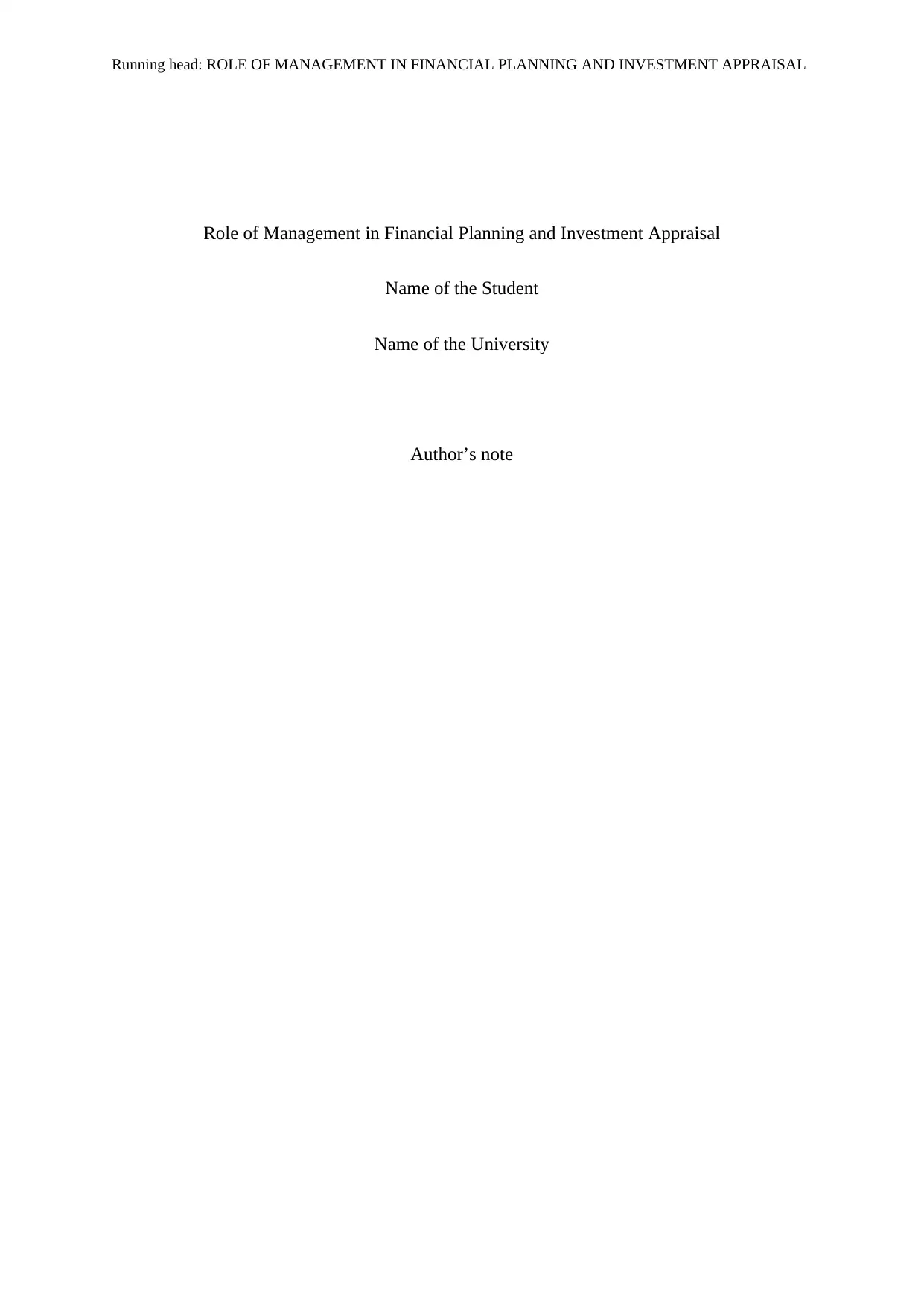
Running head: ROLE OF MANAGEMENT IN FINANCIAL PLANNING AND INVESTMENT APPRAISAL
Role of Management in Financial Planning and Investment Appraisal
Name of the Student
Name of the University
Author’s note
Role of Management in Financial Planning and Investment Appraisal
Name of the Student
Name of the University
Author’s note
Paraphrase This Document
Need a fresh take? Get an instant paraphrase of this document with our AI Paraphraser
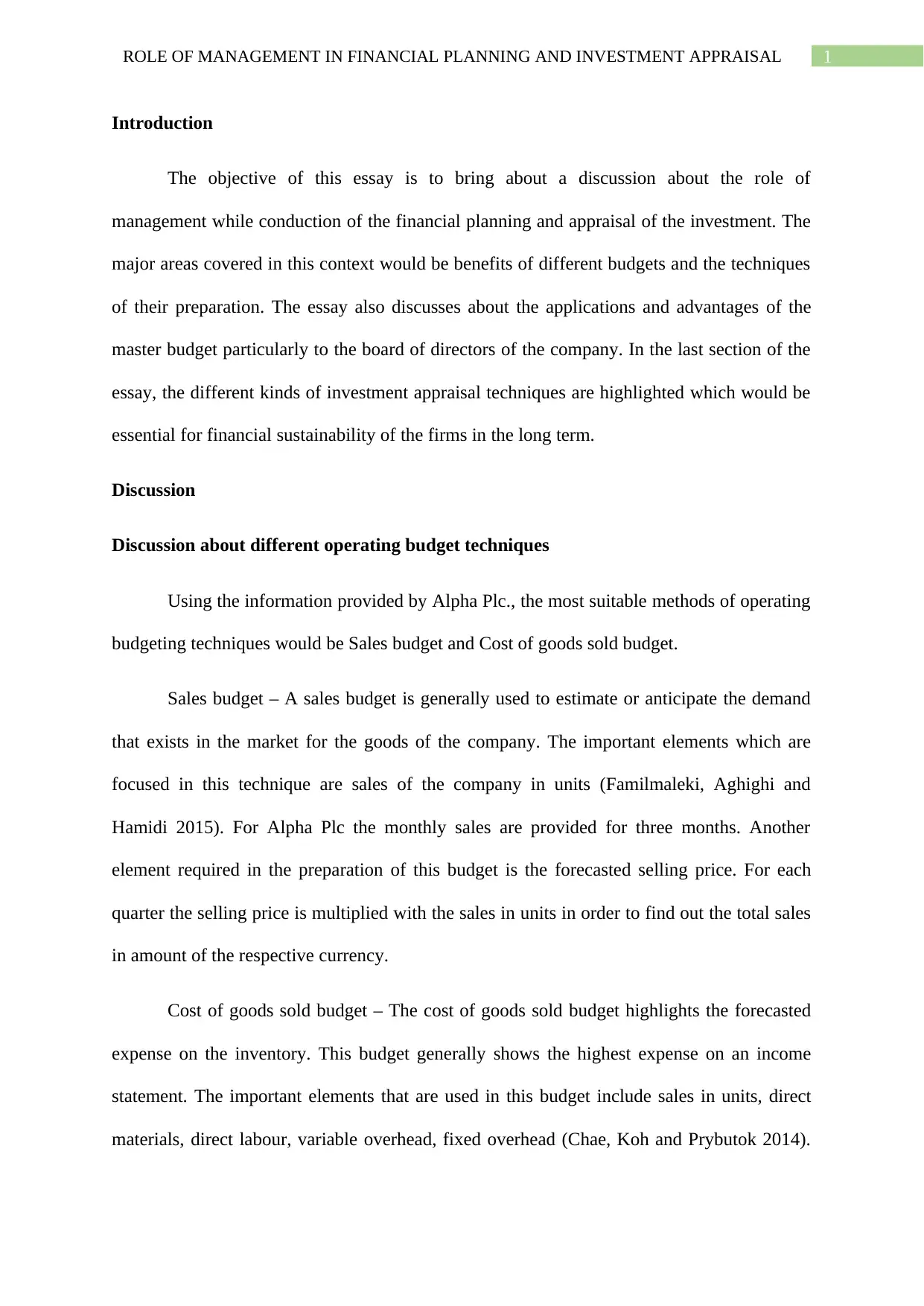
1ROLE OF MANAGEMENT IN FINANCIAL PLANNING AND INVESTMENT APPRAISAL
Introduction
The objective of this essay is to bring about a discussion about the role of
management while conduction of the financial planning and appraisal of the investment. The
major areas covered in this context would be benefits of different budgets and the techniques
of their preparation. The essay also discusses about the applications and advantages of the
master budget particularly to the board of directors of the company. In the last section of the
essay, the different kinds of investment appraisal techniques are highlighted which would be
essential for financial sustainability of the firms in the long term.
Discussion
Discussion about different operating budget techniques
Using the information provided by Alpha Plc., the most suitable methods of operating
budgeting techniques would be Sales budget and Cost of goods sold budget.
Sales budget – A sales budget is generally used to estimate or anticipate the demand
that exists in the market for the goods of the company. The important elements which are
focused in this technique are sales of the company in units (Familmaleki, Aghighi and
Hamidi 2015). For Alpha Plc the monthly sales are provided for three months. Another
element required in the preparation of this budget is the forecasted selling price. For each
quarter the selling price is multiplied with the sales in units in order to find out the total sales
in amount of the respective currency.
Cost of goods sold budget – The cost of goods sold budget highlights the forecasted
expense on the inventory. This budget generally shows the highest expense on an income
statement. The important elements that are used in this budget include sales in units, direct
materials, direct labour, variable overhead, fixed overhead (Chae, Koh and Prybutok 2014).
Introduction
The objective of this essay is to bring about a discussion about the role of
management while conduction of the financial planning and appraisal of the investment. The
major areas covered in this context would be benefits of different budgets and the techniques
of their preparation. The essay also discusses about the applications and advantages of the
master budget particularly to the board of directors of the company. In the last section of the
essay, the different kinds of investment appraisal techniques are highlighted which would be
essential for financial sustainability of the firms in the long term.
Discussion
Discussion about different operating budget techniques
Using the information provided by Alpha Plc., the most suitable methods of operating
budgeting techniques would be Sales budget and Cost of goods sold budget.
Sales budget – A sales budget is generally used to estimate or anticipate the demand
that exists in the market for the goods of the company. The important elements which are
focused in this technique are sales of the company in units (Familmaleki, Aghighi and
Hamidi 2015). For Alpha Plc the monthly sales are provided for three months. Another
element required in the preparation of this budget is the forecasted selling price. For each
quarter the selling price is multiplied with the sales in units in order to find out the total sales
in amount of the respective currency.
Cost of goods sold budget – The cost of goods sold budget highlights the forecasted
expense on the inventory. This budget generally shows the highest expense on an income
statement. The important elements that are used in this budget include sales in units, direct
materials, direct labour, variable overhead, fixed overhead (Chae, Koh and Prybutok 2014).
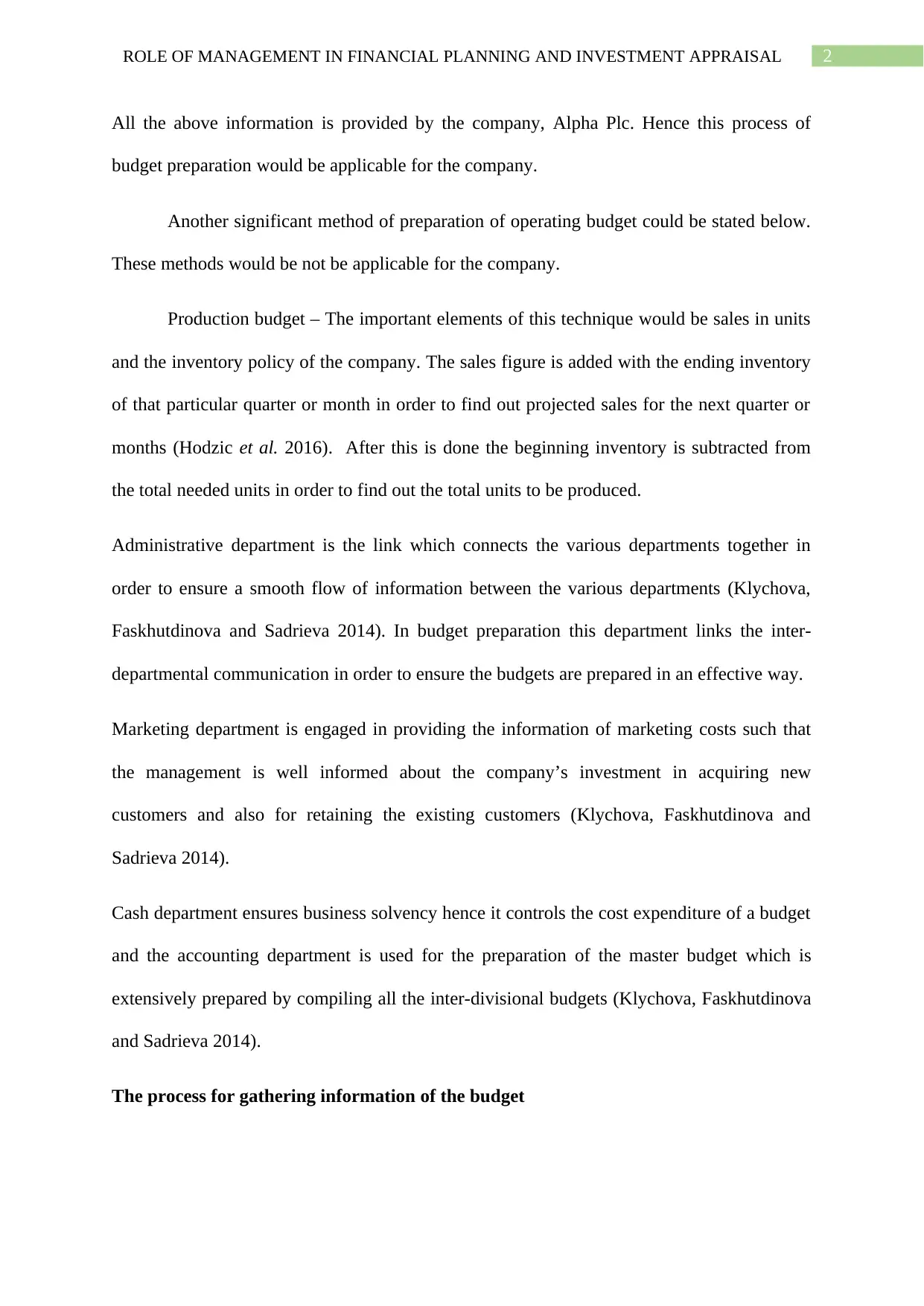
2ROLE OF MANAGEMENT IN FINANCIAL PLANNING AND INVESTMENT APPRAISAL
All the above information is provided by the company, Alpha Plc. Hence this process of
budget preparation would be applicable for the company.
Another significant method of preparation of operating budget could be stated below.
These methods would be not be applicable for the company.
Production budget – The important elements of this technique would be sales in units
and the inventory policy of the company. The sales figure is added with the ending inventory
of that particular quarter or month in order to find out projected sales for the next quarter or
months (Hodzic et al. 2016). After this is done the beginning inventory is subtracted from
the total needed units in order to find out the total units to be produced.
Administrative department is the link which connects the various departments together in
order to ensure a smooth flow of information between the various departments (Klychova,
Faskhutdinova and Sadrieva 2014). In budget preparation this department links the inter-
departmental communication in order to ensure the budgets are prepared in an effective way.
Marketing department is engaged in providing the information of marketing costs such that
the management is well informed about the company’s investment in acquiring new
customers and also for retaining the existing customers (Klychova, Faskhutdinova and
Sadrieva 2014).
Cash department ensures business solvency hence it controls the cost expenditure of a budget
and the accounting department is used for the preparation of the master budget which is
extensively prepared by compiling all the inter-divisional budgets (Klychova, Faskhutdinova
and Sadrieva 2014).
The process for gathering information of the budget
All the above information is provided by the company, Alpha Plc. Hence this process of
budget preparation would be applicable for the company.
Another significant method of preparation of operating budget could be stated below.
These methods would be not be applicable for the company.
Production budget – The important elements of this technique would be sales in units
and the inventory policy of the company. The sales figure is added with the ending inventory
of that particular quarter or month in order to find out projected sales for the next quarter or
months (Hodzic et al. 2016). After this is done the beginning inventory is subtracted from
the total needed units in order to find out the total units to be produced.
Administrative department is the link which connects the various departments together in
order to ensure a smooth flow of information between the various departments (Klychova,
Faskhutdinova and Sadrieva 2014). In budget preparation this department links the inter-
departmental communication in order to ensure the budgets are prepared in an effective way.
Marketing department is engaged in providing the information of marketing costs such that
the management is well informed about the company’s investment in acquiring new
customers and also for retaining the existing customers (Klychova, Faskhutdinova and
Sadrieva 2014).
Cash department ensures business solvency hence it controls the cost expenditure of a budget
and the accounting department is used for the preparation of the master budget which is
extensively prepared by compiling all the inter-divisional budgets (Klychova, Faskhutdinova
and Sadrieva 2014).
The process for gathering information of the budget
⊘ This is a preview!⊘
Do you want full access?
Subscribe today to unlock all pages.

Trusted by 1+ million students worldwide
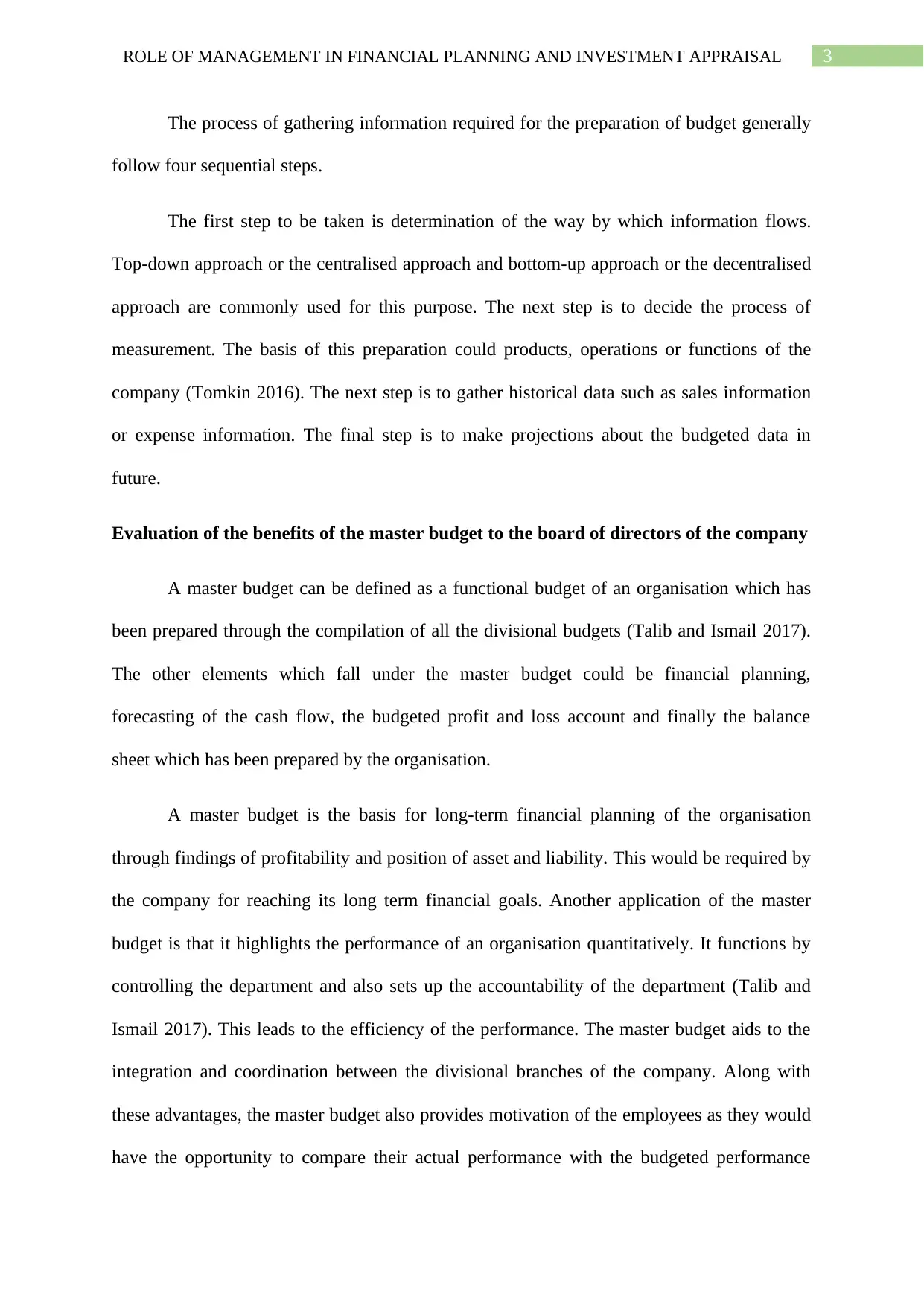
3ROLE OF MANAGEMENT IN FINANCIAL PLANNING AND INVESTMENT APPRAISAL
The process of gathering information required for the preparation of budget generally
follow four sequential steps.
The first step to be taken is determination of the way by which information flows.
Top-down approach or the centralised approach and bottom-up approach or the decentralised
approach are commonly used for this purpose. The next step is to decide the process of
measurement. The basis of this preparation could products, operations or functions of the
company (Tomkin 2016). The next step is to gather historical data such as sales information
or expense information. The final step is to make projections about the budgeted data in
future.
Evaluation of the benefits of the master budget to the board of directors of the company
A master budget can be defined as a functional budget of an organisation which has
been prepared through the compilation of all the divisional budgets (Talib and Ismail 2017).
The other elements which fall under the master budget could be financial planning,
forecasting of the cash flow, the budgeted profit and loss account and finally the balance
sheet which has been prepared by the organisation.
A master budget is the basis for long-term financial planning of the organisation
through findings of profitability and position of asset and liability. This would be required by
the company for reaching its long term financial goals. Another application of the master
budget is that it highlights the performance of an organisation quantitatively. It functions by
controlling the department and also sets up the accountability of the department (Talib and
Ismail 2017). This leads to the efficiency of the performance. The master budget aids to the
integration and coordination between the divisional branches of the company. Along with
these advantages, the master budget also provides motivation of the employees as they would
have the opportunity to compare their actual performance with the budgeted performance
The process of gathering information required for the preparation of budget generally
follow four sequential steps.
The first step to be taken is determination of the way by which information flows.
Top-down approach or the centralised approach and bottom-up approach or the decentralised
approach are commonly used for this purpose. The next step is to decide the process of
measurement. The basis of this preparation could products, operations or functions of the
company (Tomkin 2016). The next step is to gather historical data such as sales information
or expense information. The final step is to make projections about the budgeted data in
future.
Evaluation of the benefits of the master budget to the board of directors of the company
A master budget can be defined as a functional budget of an organisation which has
been prepared through the compilation of all the divisional budgets (Talib and Ismail 2017).
The other elements which fall under the master budget could be financial planning,
forecasting of the cash flow, the budgeted profit and loss account and finally the balance
sheet which has been prepared by the organisation.
A master budget is the basis for long-term financial planning of the organisation
through findings of profitability and position of asset and liability. This would be required by
the company for reaching its long term financial goals. Another application of the master
budget is that it highlights the performance of an organisation quantitatively. It functions by
controlling the department and also sets up the accountability of the department (Talib and
Ismail 2017). This leads to the efficiency of the performance. The master budget aids to the
integration and coordination between the divisional branches of the company. Along with
these advantages, the master budget also provides motivation of the employees as they would
have the opportunity to compare their actual performance with the budgeted performance
Paraphrase This Document
Need a fresh take? Get an instant paraphrase of this document with our AI Paraphraser
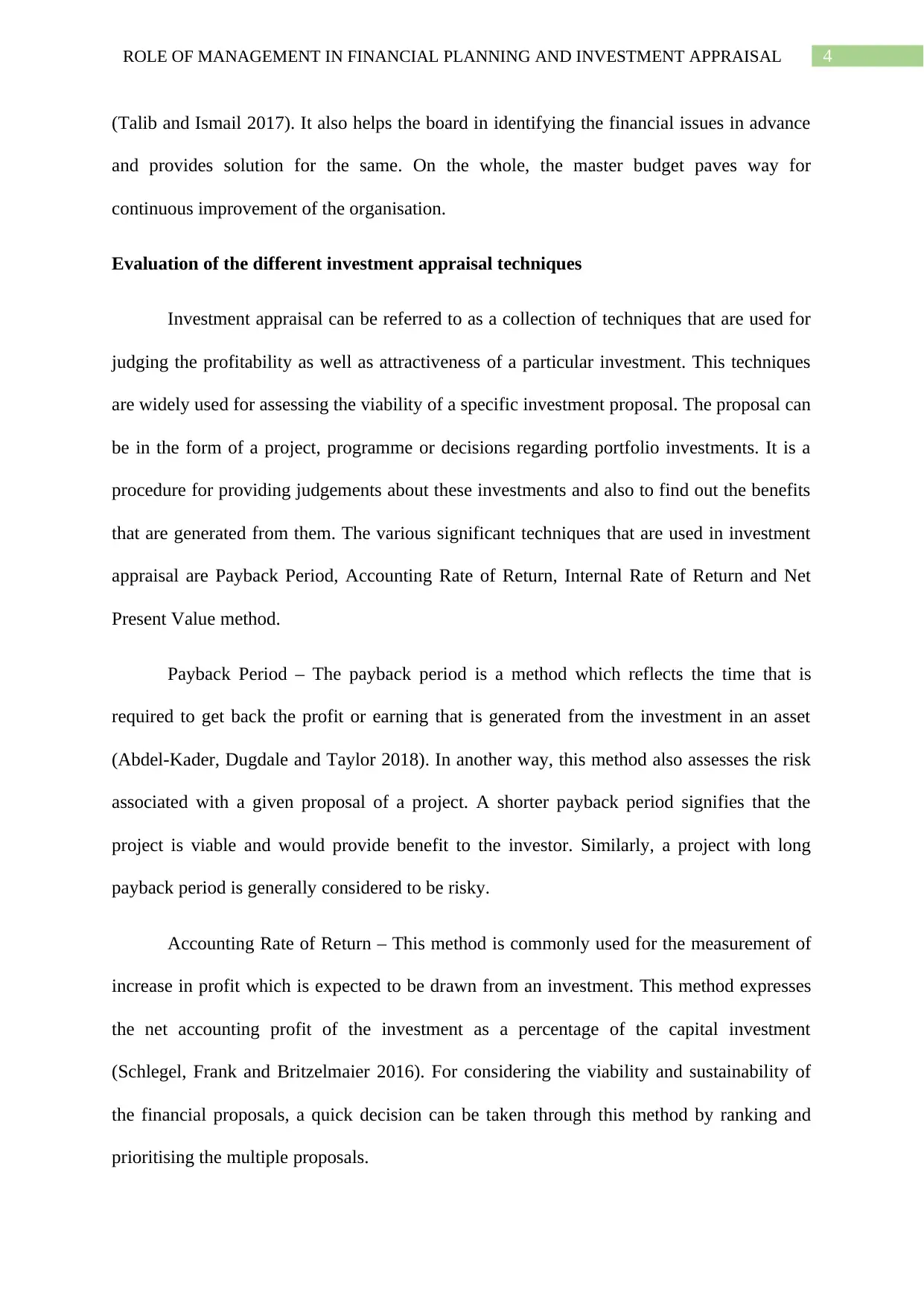
4ROLE OF MANAGEMENT IN FINANCIAL PLANNING AND INVESTMENT APPRAISAL
(Talib and Ismail 2017). It also helps the board in identifying the financial issues in advance
and provides solution for the same. On the whole, the master budget paves way for
continuous improvement of the organisation.
Evaluation of the different investment appraisal techniques
Investment appraisal can be referred to as a collection of techniques that are used for
judging the profitability as well as attractiveness of a particular investment. This techniques
are widely used for assessing the viability of a specific investment proposal. The proposal can
be in the form of a project, programme or decisions regarding portfolio investments. It is a
procedure for providing judgements about these investments and also to find out the benefits
that are generated from them. The various significant techniques that are used in investment
appraisal are Payback Period, Accounting Rate of Return, Internal Rate of Return and Net
Present Value method.
Payback Period – The payback period is a method which reflects the time that is
required to get back the profit or earning that is generated from the investment in an asset
(Abdel-Kader, Dugdale and Taylor 2018). In another way, this method also assesses the risk
associated with a given proposal of a project. A shorter payback period signifies that the
project is viable and would provide benefit to the investor. Similarly, a project with long
payback period is generally considered to be risky.
Accounting Rate of Return – This method is commonly used for the measurement of
increase in profit which is expected to be drawn from an investment. This method expresses
the net accounting profit of the investment as a percentage of the capital investment
(Schlegel, Frank and Britzelmaier 2016). For considering the viability and sustainability of
the financial proposals, a quick decision can be taken through this method by ranking and
prioritising the multiple proposals.
(Talib and Ismail 2017). It also helps the board in identifying the financial issues in advance
and provides solution for the same. On the whole, the master budget paves way for
continuous improvement of the organisation.
Evaluation of the different investment appraisal techniques
Investment appraisal can be referred to as a collection of techniques that are used for
judging the profitability as well as attractiveness of a particular investment. This techniques
are widely used for assessing the viability of a specific investment proposal. The proposal can
be in the form of a project, programme or decisions regarding portfolio investments. It is a
procedure for providing judgements about these investments and also to find out the benefits
that are generated from them. The various significant techniques that are used in investment
appraisal are Payback Period, Accounting Rate of Return, Internal Rate of Return and Net
Present Value method.
Payback Period – The payback period is a method which reflects the time that is
required to get back the profit or earning that is generated from the investment in an asset
(Abdel-Kader, Dugdale and Taylor 2018). In another way, this method also assesses the risk
associated with a given proposal of a project. A shorter payback period signifies that the
project is viable and would provide benefit to the investor. Similarly, a project with long
payback period is generally considered to be risky.
Accounting Rate of Return – This method is commonly used for the measurement of
increase in profit which is expected to be drawn from an investment. This method expresses
the net accounting profit of the investment as a percentage of the capital investment
(Schlegel, Frank and Britzelmaier 2016). For considering the viability and sustainability of
the financial proposals, a quick decision can be taken through this method by ranking and
prioritising the multiple proposals.
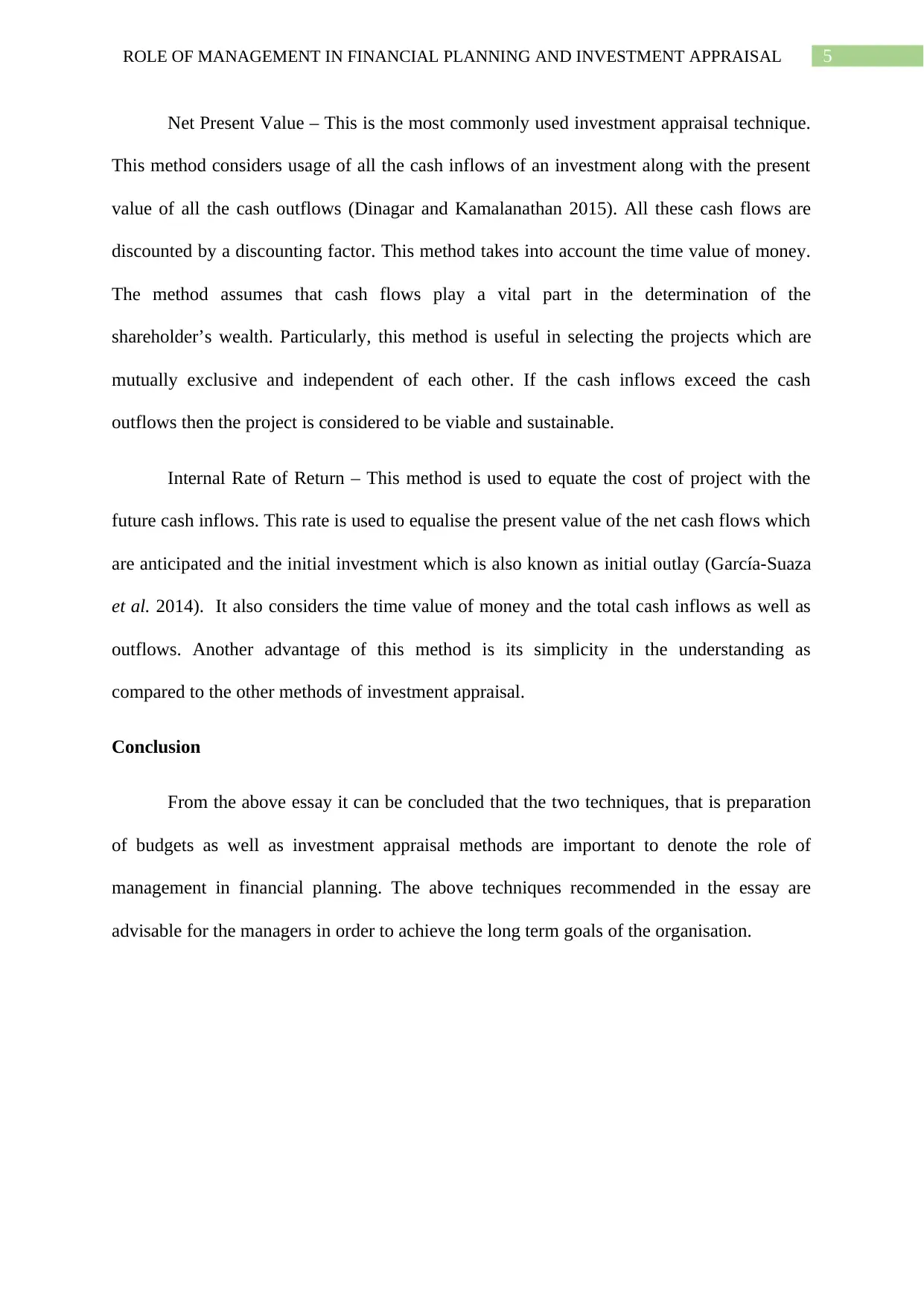
5ROLE OF MANAGEMENT IN FINANCIAL PLANNING AND INVESTMENT APPRAISAL
Net Present Value – This is the most commonly used investment appraisal technique.
This method considers usage of all the cash inflows of an investment along with the present
value of all the cash outflows (Dinagar and Kamalanathan 2015). All these cash flows are
discounted by a discounting factor. This method takes into account the time value of money.
The method assumes that cash flows play a vital part in the determination of the
shareholder’s wealth. Particularly, this method is useful in selecting the projects which are
mutually exclusive and independent of each other. If the cash inflows exceed the cash
outflows then the project is considered to be viable and sustainable.
Internal Rate of Return – This method is used to equate the cost of project with the
future cash inflows. This rate is used to equalise the present value of the net cash flows which
are anticipated and the initial investment which is also known as initial outlay (García-Suaza
et al. 2014). It also considers the time value of money and the total cash inflows as well as
outflows. Another advantage of this method is its simplicity in the understanding as
compared to the other methods of investment appraisal.
Conclusion
From the above essay it can be concluded that the two techniques, that is preparation
of budgets as well as investment appraisal methods are important to denote the role of
management in financial planning. The above techniques recommended in the essay are
advisable for the managers in order to achieve the long term goals of the organisation.
Net Present Value – This is the most commonly used investment appraisal technique.
This method considers usage of all the cash inflows of an investment along with the present
value of all the cash outflows (Dinagar and Kamalanathan 2015). All these cash flows are
discounted by a discounting factor. This method takes into account the time value of money.
The method assumes that cash flows play a vital part in the determination of the
shareholder’s wealth. Particularly, this method is useful in selecting the projects which are
mutually exclusive and independent of each other. If the cash inflows exceed the cash
outflows then the project is considered to be viable and sustainable.
Internal Rate of Return – This method is used to equate the cost of project with the
future cash inflows. This rate is used to equalise the present value of the net cash flows which
are anticipated and the initial investment which is also known as initial outlay (García-Suaza
et al. 2014). It also considers the time value of money and the total cash inflows as well as
outflows. Another advantage of this method is its simplicity in the understanding as
compared to the other methods of investment appraisal.
Conclusion
From the above essay it can be concluded that the two techniques, that is preparation
of budgets as well as investment appraisal methods are important to denote the role of
management in financial planning. The above techniques recommended in the essay are
advisable for the managers in order to achieve the long term goals of the organisation.
⊘ This is a preview!⊘
Do you want full access?
Subscribe today to unlock all pages.

Trusted by 1+ million students worldwide
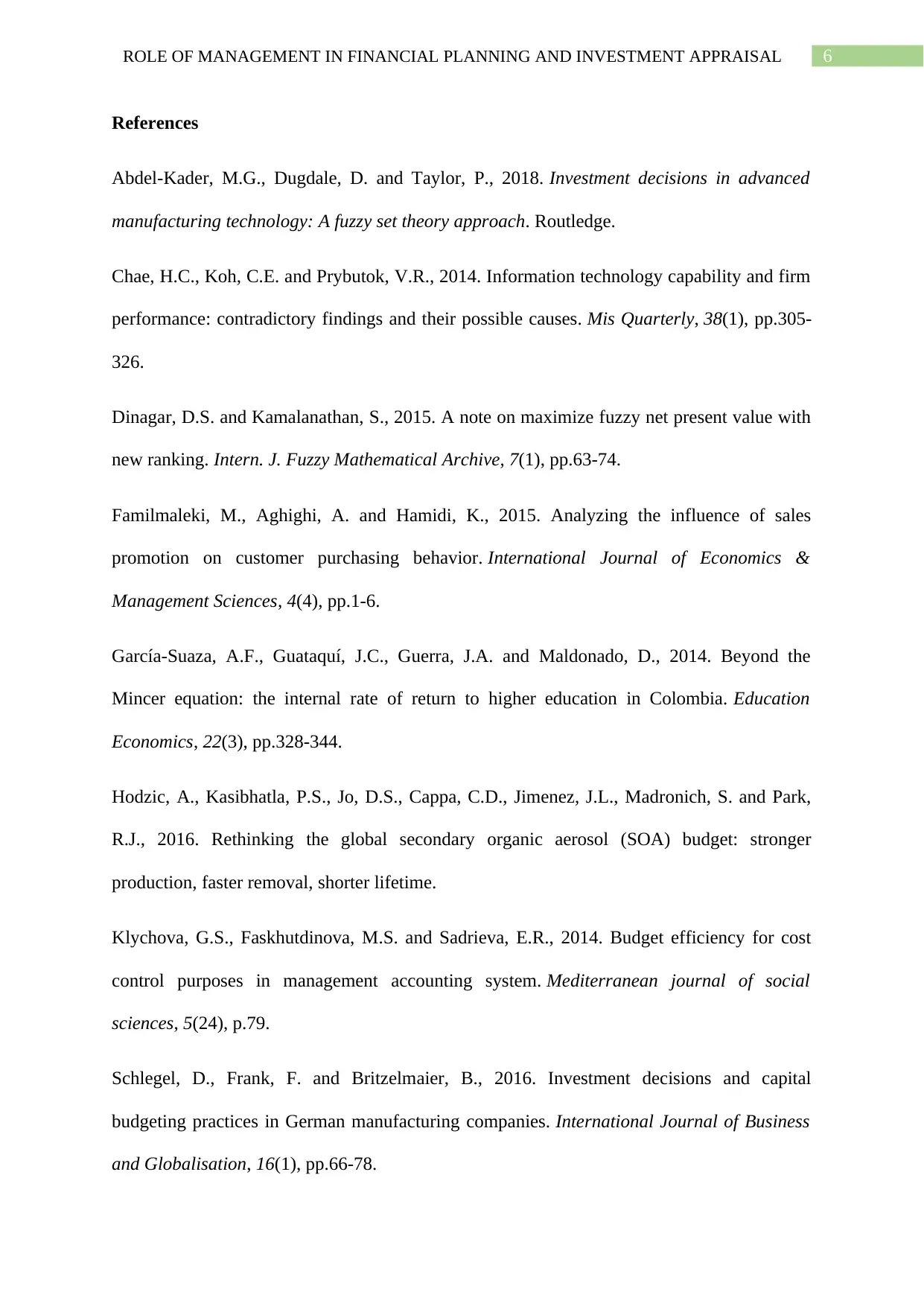
6ROLE OF MANAGEMENT IN FINANCIAL PLANNING AND INVESTMENT APPRAISAL
References
Abdel-Kader, M.G., Dugdale, D. and Taylor, P., 2018. Investment decisions in advanced
manufacturing technology: A fuzzy set theory approach. Routledge.
Chae, H.C., Koh, C.E. and Prybutok, V.R., 2014. Information technology capability and firm
performance: contradictory findings and their possible causes. Mis Quarterly, 38(1), pp.305-
326.
Dinagar, D.S. and Kamalanathan, S., 2015. A note on maximize fuzzy net present value with
new ranking. Intern. J. Fuzzy Mathematical Archive, 7(1), pp.63-74.
Familmaleki, M., Aghighi, A. and Hamidi, K., 2015. Analyzing the influence of sales
promotion on customer purchasing behavior. International Journal of Economics &
Management Sciences, 4(4), pp.1-6.
García-Suaza, A.F., Guataquí, J.C., Guerra, J.A. and Maldonado, D., 2014. Beyond the
Mincer equation: the internal rate of return to higher education in Colombia. Education
Economics, 22(3), pp.328-344.
Hodzic, A., Kasibhatla, P.S., Jo, D.S., Cappa, C.D., Jimenez, J.L., Madronich, S. and Park,
R.J., 2016. Rethinking the global secondary organic aerosol (SOA) budget: stronger
production, faster removal, shorter lifetime.
Klychova, G.S., Faskhutdinova, М.S. and Sadrieva, E.R., 2014. Budget efficiency for cost
control purposes in management accounting system. Mediterranean journal of social
sciences, 5(24), p.79.
Schlegel, D., Frank, F. and Britzelmaier, B., 2016. Investment decisions and capital
budgeting practices in German manufacturing companies. International Journal of Business
and Globalisation, 16(1), pp.66-78.
References
Abdel-Kader, M.G., Dugdale, D. and Taylor, P., 2018. Investment decisions in advanced
manufacturing technology: A fuzzy set theory approach. Routledge.
Chae, H.C., Koh, C.E. and Prybutok, V.R., 2014. Information technology capability and firm
performance: contradictory findings and their possible causes. Mis Quarterly, 38(1), pp.305-
326.
Dinagar, D.S. and Kamalanathan, S., 2015. A note on maximize fuzzy net present value with
new ranking. Intern. J. Fuzzy Mathematical Archive, 7(1), pp.63-74.
Familmaleki, M., Aghighi, A. and Hamidi, K., 2015. Analyzing the influence of sales
promotion on customer purchasing behavior. International Journal of Economics &
Management Sciences, 4(4), pp.1-6.
García-Suaza, A.F., Guataquí, J.C., Guerra, J.A. and Maldonado, D., 2014. Beyond the
Mincer equation: the internal rate of return to higher education in Colombia. Education
Economics, 22(3), pp.328-344.
Hodzic, A., Kasibhatla, P.S., Jo, D.S., Cappa, C.D., Jimenez, J.L., Madronich, S. and Park,
R.J., 2016. Rethinking the global secondary organic aerosol (SOA) budget: stronger
production, faster removal, shorter lifetime.
Klychova, G.S., Faskhutdinova, М.S. and Sadrieva, E.R., 2014. Budget efficiency for cost
control purposes in management accounting system. Mediterranean journal of social
sciences, 5(24), p.79.
Schlegel, D., Frank, F. and Britzelmaier, B., 2016. Investment decisions and capital
budgeting practices in German manufacturing companies. International Journal of Business
and Globalisation, 16(1), pp.66-78.
Paraphrase This Document
Need a fresh take? Get an instant paraphrase of this document with our AI Paraphraser

7ROLE OF MANAGEMENT IN FINANCIAL PLANNING AND INVESTMENT APPRAISAL
Talib, N.F.M. and Ismail, R.A.M., 2017. Effect of Financial Management on Budget and
Budgeting Process. International Journal of Business and Management, 1(1), pp.18-21.
Tomkin, S.L., 2016. Inside OMB: Politics and Process in the President's Budget Office:
Politics and Process in the President's Budget Office. Routledge.
Talib, N.F.M. and Ismail, R.A.M., 2017. Effect of Financial Management on Budget and
Budgeting Process. International Journal of Business and Management, 1(1), pp.18-21.
Tomkin, S.L., 2016. Inside OMB: Politics and Process in the President's Budget Office:
Politics and Process in the President's Budget Office. Routledge.
1 out of 8
Related Documents
Your All-in-One AI-Powered Toolkit for Academic Success.
+13062052269
info@desklib.com
Available 24*7 on WhatsApp / Email
![[object Object]](/_next/static/media/star-bottom.7253800d.svg)
Unlock your academic potential
Copyright © 2020–2025 A2Z Services. All Rights Reserved. Developed and managed by ZUCOL.





